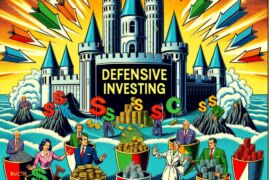“Investing,” Mark Twain once said, “should be more like watching paint dry or watching grass grow. If you want excitement, take $800 and go to Las Vegas.” Now, as any experienced investor will tell you, the journey of investing is rarely that dull. Why? Because of a little thing called ‘risk.’
Concept of Risk in Investing
In the world of investing, risk is as omnipresent as air, a constant companion that can either give you a lift or throw you off balance. But what exactly is risk in investing? In its simplest terms, risk represents the possibility that the actual returns on an investment will be different from the expected returns. It’s a measure of uncertainty, the volatility that separates the calm predictability of watching paint dry from the adrenaline-fueled thrill (and sometimes despair) of the investment world.

Risk Management in Portfolio Construction and Maintenance
Just like a symphony conductor expertly managing an orchestra, an investor must masterfully manage the risks associated with their portfolio. Risk management is not about completely eliminating risk – for that would mean eliminating potential returns as well. Instead, it’s about understanding these risks, taking measured amounts that align with one’s goals and comfort levels, and mitigating those that could lead to substantial losses.
Effective risk management is a cornerstone of successful investing. It is an ongoing process that begins with the construction of your portfolio and continues through its maintenance, shaping every decision from what assets to include, to how much to invest in each, to when to exit a position. It’s not the most glamorous aspect of investing, but like the solid foundation beneath a skyscraper, it’s what underpins and supports the entire structure.
Without a doubt, managing risk is complex, often daunting. But fear not, dear reader! In this guide, we will break it down into manageable pieces, providing you with the tools and understanding you need to confidently manage risk in your investment portfolio. Let’s embark on this journey together, shall we?

Understanding Investment Risk
Definition and Types of Investment Risk
To tackle risk head-on, we first need to dissect it, understand its forms and faces. The risks in investing are a bit like the villains in a superhero movie – there’s a whole rogue’s gallery of them, each with unique characteristics and the potential to upset your heroic quest for financial growth.
- Market Risk: This is the big kahuna of investment risks, the overarching threat that affects almost every asset you might invest in. It represents the potential for the entire market or asset class to decline, dragging your investments down with it. Think of economic recessions, geopolitical events, or a global pandemic.
- Credit Risk: This is particularly relevant if you’re invested in bonds or other debt instruments. It’s the danger that the entity you’ve lent money to (by buying their bonds) won’t be able to pay you back.
- Liquidity Risk: Ever tried to sell something quickly but found no buyers? That’s liquidity risk – the possibility that you can’t buy or sell an investment promptly without affecting its price substantially.
- Concentration Risk: This occurs when you’ve got too many of your investment eggs in one basket. If that basket drops (i.e., a particular asset or sector crashes), your portfolio can suffer significant damage.

The Relationship Between Risk and Return
Now, you may be thinking, “With all these risks, why bother investing at all?” Well, because of an essential reality in investing: risk and return are inseparably entwined, like the strands of a DNA molecule. The potential for higher returns generally comes with a higher level of risk. It’s akin to the thrill of a roller coaster – the higher the climb (representing risk), the more exhilarating the descent (representing potential returns).

How Individual Investor Circumstances Influence Risk Tolerance
Just as every superhero has their unique powers and weaknesses, every investor has their individual circumstances – financial goals, investment horizon, financial cushion, income level, and emotional tolerance for risk.
For instance, a young professional with a steady income and years ahead till retirement may be more willing to take on higher-risk investments for potentially greater returns. Contrastingly, a retiree whose income comes largely from their investments might prefer less risky assets that provide stable income.
Risk tolerance is an intimate, personal aspect of investing. It’s about looking inward, understanding not just your financial situation but your emotional capacity to withstand market downturns. There’s no one-size-fits-all risk profile, just as there’s no universal superhero suit.
Understanding your risk tolerance is crucial to constructing a portfolio that not only has the potential to reach your financial goals, but also lets you sleep peacefully at night. After all, what’s wealth without peace of mind?
source: WEALTHTRACK on YouTube
Key Strategies for Risk Management

The Role of Diversification in Risk Management
Imagine you’re setting out on a journey through a magical, dangerous land. Would you bring only a sword, no matter how shiny and sharp? Or would you pack a mix of weapons – perhaps a bow and arrows, a shield, and a few health potions, too?
In the quest of investing, diversification is your mixed bag of tools. It’s about spreading your investments across different types of assets (like stocks, bonds, real estate) and various sectors or regions, thereby spreading the risk.
Think of it this way: if one of your investments is the proverbial sinking ship, having other investments that are performing well can help keep your portfolio afloat. It’s the financial embodiment of not putting all your eggs in one basket.
Remember, diversification is not about guaranteeing profits or shielding completely against loss; instead, it’s about improving the chances of achieving your long-term financial goals and smoothing your journey through the wilds of the market.
Understanding and Implementing Asset Allocation
If diversification is your mixed bag of tools, asset allocation decides how many of each tool you carry. It’s the strategy of dividing your investment portfolio among different asset classes such as stocks, bonds, and cash.
The right mix for you depends on many factors, including your risk tolerance, investment horizon, and financial goals. For example, a younger investor with a higher risk tolerance might have a higher percentage of riskier assets like stocks, while an older investor nearing retirement might lean more heavily on bonds for their relative stability and consistent income.
One way to think of asset allocation is like a meal plan. Just as a balanced diet includes varying amounts of proteins, carbs, and fats, a balanced portfolio contains a mix of asset types in proportions that align with your financial ‘health’ and ‘dietary’ needs.
The Importance of Portfolio Rebalancing
As time passes, your meticulously planned asset allocation can start to veer off course. Maybe the stocks in your portfolio had a particularly good run, and now they make up a much larger piece of the pie than you’d originally intended, increasing your risk exposure.
Enter portfolio rebalancing, the act of realigning the weightings of your portfolio’s assets to maintain your desired asset allocation. It’s a bit like pruning a garden – trimming back the overgrown areas (selling assets that have increased in proportion) and filling in the bare spots (buying assets that have decreased in proportion).
Rebalancing is not something you need to do constantly, but it’s a good practice to review your portfolio periodically (for example, annually) or when there’s a significant change in your financial circumstances. It’s one of the ways to ensure your portfolio keeps reflecting your investment goals and risk tolerance, maintaining the garden of your investments in its optimal state.
Remember, managing risk isn’t about fearing or avoiding it. It’s about understanding it, embracing it, and making it work for you on your terms. It’s about taking the driver’s seat in the thrilling journey of investing!
source: Interactive Brokers on YouTube
Advanced Risk Management Techniques
Use of Derivatives for Hedging
Step into the risk management advanced class, and meet the derivatives – financial contracts whose value is derived from underlying assets. They can be complex, like solving a 3D jigsaw puzzle, but when used strategically, derivatives can form an effective part of a risk management strategy.
Imagine a farmer who grows corn. He’s vulnerable to the whims of the weather and the fluctuating corn prices. So, he sells a futures contract promising to sell his corn at a fixed price at a future date. This way, even if corn prices drop dramatically, he’s locked in a price, protecting himself against the risk. That’s hedging via derivatives.
In the investment world, options and futures can be used similarly to hedge against potential losses. By owning a mix of assets and derivatives, investors can insulate themselves from unfavorable movements in their portfolios. But remember, while derivatives can protect, they can also introduce new risks and costs. It’s crucial to understand them fully or seek professional advice before diving in.
Implementing a Stop-Loss Strategy
Have you ever been on a rollercoaster ride and wished there was an emergency stop button you could hit if the ride got too wild? In the world of investing, there’s a mechanism that does something similar – the stop-loss order.
A stop-loss order is an order placed with a broker to buy or sell once the stock reaches a certain price. It’s designed to limit an investor’s loss on a security position. Think of it as a pre-determined exit point if the market doesn’t move in your favor.
But it’s not a fail-safe. Fast-moving markets can ‘gap’ past stop levels, leading to trades executed at less favorable prices. And a stop-loss can also cap potential gains if the market fluctuates but then recovers. However, for some, the trade-off is worth it for the protection it offers.

Considering Insurance as a Risk Management Strategy
Just like you would insure your home or car against unforeseen damages, you can use insurance strategies to protect your portfolio. Welcome to the world of asset protection, where the language of annuities, life insurance, and long-term care insurance is spoken.
Annuities, for example, can provide a steady income stream during retirement, acting as a hedge against the risk of outliving your savings. Life insurance policies can protect your dependents financially in case of your untimely demise, ensuring that a market downturn won’t jeopardize their future.
Remember, insurance products can be complex, and they’re not suitable for every investor. But for some, they can provide an added layer of protection, creating a buffer against the hard knocks that life and the markets can deliver.
In the vast universe of investing, risks are as integral as stars in the night sky. But remember, every star can be navigated, and every risk can be managed. The key lies in knowledge, planning, and perhaps a dash of adventure.
source: Financial Wisdom on YouTube
Maintaining Emotional Control and Discipline

The Psychological Challenges of Risk Management
If there’s one thing that we can all agree on, it’s that the human brain is a complex organ. It’s full of quirks, intricacies, and tendencies, all of which can impact our ability to manage risk effectively in investing.
Imagine you’ve just invested in a company whose stocks are currently soaring. The thrill of the ride up is intoxicating, and you’re envisioning a future where the climb continues indefinitely. But then, the market shifts, the stock plummets, and your portfolio along with it. Suddenly, the future doesn’t seem so bright. This is where the psychological challenges of investing come into play.
The heart-racing thrill of soaring stocks and the gut-punch of plunging ones can cloud our judgment. We’re naturally inclined to chase after gains and avoid losses – it’s a hard-wired survival instinct. But this instinct can sometimes lead us to make hasty, emotional decisions, like selling low out of fear or buying high out of greed.

The Dangers of Emotional Investing
It’s been said that the stock market is a device for transferring money from the impatient to the patient. The “impatient” in this context are often those who let their emotions control their investing decisions.
When fear or euphoria takes the driver’s seat, we can find ourselves swerving out of our well-planned investment lane into oncoming traffic. Panic selling during a downturn, or recklessly buying during an upswing, can seriously harm portfolio performance over time. And once made, these impulsive decisions can be difficult to reverse.
Strategies for Maintaining Discipline During Market Volatility
So how do you keep your cool when the market heat is on? Here are a few strategies:
- Set a Clear Investment Plan: Your plan is your North Star, guiding your decisions regardless of the market weather. It should outline your investment goals, risk tolerance, and strategies for diversification and rebalancing. Revisit and tweak the plan periodically, but avoid major changes based on temporary market conditions.
- Practice Regular Rebalancing: This systematic approach ensures you stick to your intended asset allocation, selling high and buying low without letting emotions get in the way. It’s like a regular investment health check-up, keeping your portfolio in shape.
- Focus on the Long-Term: Remember, investing is more marathon than sprint. Short-term market fluctuations are part and parcel of the journey. Maintain perspective by focusing on your long-term goals and the historical tendency of markets to rise over extended periods.
- Consider Professional Help: Financial advisors or robo-advisors can provide an objective view of your portfolio and help manage risks, especially during volatile times.
Remember, investing is not just a financial endeavor, but also an emotional and psychological one. Being aware of this can help you navigate market ups and downs with equanimity and wisdom. After all, the most rewarding adventures are often those that challenge us the most!

Seeking Professional Advice
When and Why to Seek Advice from a Financial Advisor
Investing, while richly rewarding, can also be complex and nerve-racking. Even seasoned investors may find themselves lost in a labyrinth of ticker symbols, P/E ratios, yield curves, and so much more. This is where a financial advisor can provide immense value.
But when is the right time to seek advice? The truth is, there’s no one-size-fits-all answer. Some individuals might reach out to a financial advisor early on in their investing journey, while others might only do so when they’ve amassed a sizeable portfolio, are nearing retirement, or are facing a significant life change, such as receiving an inheritance or getting divorced.
Financial advisors offer personalized advice, helping to create an investment strategy that aligns with your financial goals, risk tolerance, and time horizon. They can also assist with tax planning, estate planning, insurance, and retirement, offering a holistic approach to managing your financial health.

The Role of Robo-Advisors in Risk Management
In the digital age, we have seen the rise of robo-advisors: automated platforms that use algorithms to manage your investment portfolio. These digital advisors are typically less expensive than their human counterparts, making them an attractive option for cost-conscious investors.
Robo-advisors can play a key role in risk management. They take emotion out of the equation, systematically rebalancing your portfolio to maintain your chosen level of risk. This can be particularly useful during market volatility when human investors may be tempted to stray from their investment plan due to fear or greed.
However, robo-advisors may not be for everyone. While they excel at managing investments in a structured and systematic way, they lack the personal touch of a human advisor. Complex financial planning or addressing unique financial situations may be better suited to a human touch.
The Value of Continuous Financial Education
Perhaps one of the most underrated aspects of investing is the importance of continuous financial education. Markets evolve, new investment vehicles emerge, tax laws change, and personal circumstances shift. To stay ahead of the curve, it’s crucial to keep learning.
Books, online courses, webinars, podcasts, industry reports – there’s a wealth of information out there waiting to be explored. Continuous learning not only equips you to make more informed investment decisions but also fosters confidence, helping you to navigate the market turbulence with a calm and steady hand.
A Chinese proverb says, “Learning is like rowing upstream: not to advance is to drop back.” So, keep paddling, my fellow investors, and may your investment journey be one of continuous discovery and growth!
source: The Plain Bagel on YouTube
12-Question FAQ: Managing Risk in Your Investment Portfolio
1) What does “risk” mean in investing?
It’s the chance actual returns differ from expected returns—driven by market moves, business fundamentals, interest rates, inflation, liquidity, concentration, and behavior.
2) Which risks matter most for typical investors?
Market risk (broad declines)
Business/credit risk (default, earnings shocks)
Interest-rate & inflation risk (bond prices, purchasing power)
Liquidity risk (can’t trade at a fair price)
Concentration risk (too much in one name/sector)
Sequence-of-returns risk (bad early returns in retirement)
3) How do I match risk to my situation?
Align with goals, horizon, cash flow needs, human capital stability, and your emotional tolerance. Longer horizons and stable income typically allow more equity risk; near-term spending needs call for safer assets.
4) What is asset allocation and why is it central?
It’s your mix of stocks/bonds/cash/alternatives. Allocation explains most outcome variability and is the primary lever for targeting return and controlling drawdowns.
5) How does diversification reduce risk?
Owning assets that don’t move in lockstep dampens volatility and cushions losses. Diversify across asset classes, sectors, geographies, and factors (e.g., size, value, quality).
6) How often should I rebalance?
Commonly annually or when weights drift beyond set bands (e.g., ±5%). Rebalancing systematically sells relative winners, buys losers, restoring your intended risk.
7) What position-sizing rules help control damage?
Use max single-position caps (e.g., 5–10%), sector caps, and size riskier assets smaller. For individual securities, some investors target a max loss per position (e.g., 1% of portfolio).
8) Are derivatives useful for risk management?
Yes—puts can insure downside, futures can hedge equity or rate exposure. They cost money/complexity, so use sparingly and purposefully (define hedge target, size, and exit).
9) Should I use stop-losses?
They can limit tail losses and remove emotion, but may trigger in gaps/whipsaws. If used, pair with position sizing and consider alerts or trailing stops rather than tight static levels.
10) How do I manage risk in retirement withdrawals?
Lower sequence risk with cash buckets, bond ladders, flexible withdrawals, or partial annuities. Keep 1–3 years of spending in low-volatility assets to avoid selling equities in deep declines.
11) What behavioral practices cut risk?
Write an Investment Policy Statement (IPS), automate contributions/rebalancing, predefine sell rules, and avoid news-driven trades. Process beats impulse.
12) What’s a simple risk-management checklist?
Clear goal, horizon, IPS
Suitable allocation and diversification
Emergency fund (3–12 months)
Position/sector caps
Rebalance rules
Hedging policy (if any)
Tax location & cost control
Periodic review/stress tests (e.g., –20%, –30% equity shocks)
Conclusion: Importance of Risk Management in Investing
As we near the end of our journey through the realm of risk management in investing, let’s take a moment to reflect on the significance of this crucial aspect. Risk management is the sturdy shield that protects your hard-earned wealth from the perils that lurk in the world of finance. It’s the compass that keeps you on course, ensuring your investments align with your goals and risk tolerance.
Throughout this guide, we explored the various dimensions of risk, from market volatility to emotional pitfalls. We delved into strategies like diversification, asset allocation, and rebalancing, discovering how they fortify your portfolio against potential setbacks. We also uncovered advanced techniques such as hedging with derivatives and the value of seeking professional advice. Armed with this knowledge, you’re equipped to navigate the twists and turns of the investment landscape with greater confidence.

Actively Manage Risk as Part of a Sound Investment Strategy
Investing is a dynamic endeavor, an ongoing dance between risk and reward. It’s not a passive spectator sport where you sit back and hope for the best. No, dear reader, managing risk requires an active stance. It demands vigilance, discipline, and an unwavering commitment to your financial well-being.
By actively managing risk, you become the conductor of your financial symphony. You adjust the volume of your investments, balancing the potential for returns with the need for protection. You fine-tune your asset allocation, ensuring it aligns with your changing circumstances and aspirations. You stay vigilant, ever watchful for potential threats and opportunities that arise.
Review and Adjust Investment Strategies
As we bid farewell, remember that risk management is not a one-time endeavor. The investment landscape is ever-evolving, and so should your strategies. Regularly review your investment portfolio, reassess your risk tolerance, and adjust your strategies accordingly. Be open to seeking professional advice when needed and embrace continuous learning to stay at the forefront of financial knowledge.
In the end, your investment journey is a personal one, tailored to your unique circumstances, goals, and dreams. Take the time to review your investment plan, evaluate your risk appetite, and make any necessary adjustments. The path to financial success is not without challenges, but by actively managing risk, you can navigate with confidence and pursue your aspirations.
So, my fellow risk managers, go forth with courage and prudence. Harness the power of risk management, secure in the knowledge that you have fortified your financial fortress against the uncertainties of the market. May your investments thrive, and may your journey towards financial prosperity be paved with astute risk management.
Important Information
Comprehensive Investment Disclaimer:
All content provided on this website (including but not limited to portfolio ideas, fund analyses, investment strategies, commentary on market conditions, and discussions regarding leverage) is strictly for educational, informational, and illustrative purposes only. The information does not constitute financial, investment, tax, accounting, or legal advice. Opinions, strategies, and ideas presented herein represent personal perspectives, are based on independent research and publicly available information, and do not necessarily reflect the views or official positions of any third-party organizations, institutions, or affiliates.
Investing in financial markets inherently carries substantial risks, including but not limited to market volatility, economic uncertainties, geopolitical developments, and liquidity risks. You must be fully aware that there is always the potential for partial or total loss of your principal investment. Additionally, the use of leverage or leveraged financial products significantly increases risk exposure by amplifying both potential gains and potential losses, and thus is not appropriate or advisable for all investors. Using leverage may result in losing more than your initial invested capital, incurring margin calls, experiencing substantial interest costs, or suffering severe financial distress.
Past performance indicators, including historical data, backtesting results, and hypothetical scenarios, should never be viewed as guarantees or reliable predictions of future performance. Any examples provided are purely hypothetical and intended only for illustration purposes. Performance benchmarks, such as market indexes mentioned on this site, are theoretical and are not directly investable. While diligent efforts are made to provide accurate and current information, “Picture Perfect Portfolios” does not warrant, represent, or guarantee the accuracy, completeness, or timeliness of any information provided. Errors, inaccuracies, or outdated information may exist.
Users of this website are strongly encouraged to independently verify all information, conduct comprehensive research and due diligence, and engage with qualified financial, investment, tax, or legal professionals before making any investment or financial decisions. The responsibility for making informed investment decisions rests entirely with the individual. “Picture Perfect Portfolios” explicitly disclaims all liability for any direct, indirect, incidental, special, consequential, or other losses or damages incurred, financial or otherwise, arising out of reliance upon, or use of, any content or information presented on this website.
By accessing, reading, and utilizing the content on this website, you expressly acknowledge, understand, accept, and agree to abide by these terms and conditions. Please consult the full and detailed disclaimer available elsewhere on this website for further clarification and additional important disclosures. Read the complete disclaimer here.





